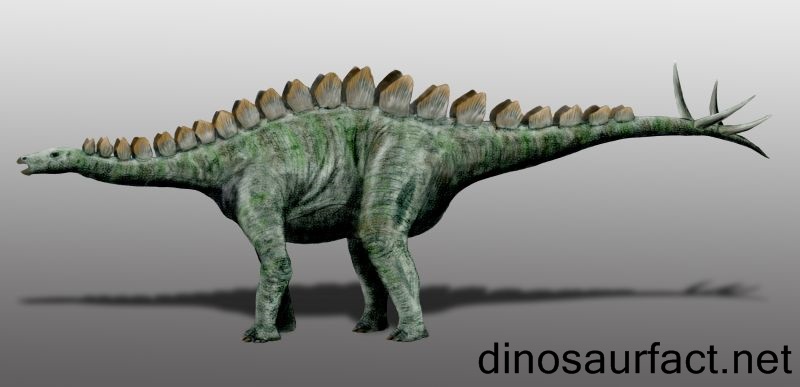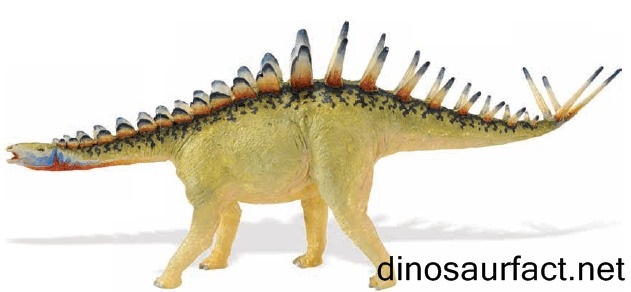 Click to visit the previous dinosaur bio
Click to visit the previous dinosaur bio
 |
|
 |
|
Kingdom: Animalia
Phylum: Chordata
Class: Sauropsida
SuperOrder: Dinosauria
Order: Ornithischia
SubOrder: Stegosauria
Family: Stegosauridae
Genus: Miragaia longicollum
 |
|
 |
|
 |
|

Stegosaurian dinosaurs have been described by paleontologists as a quadrupled stance herbivore with characteristically short limb and short neck. Over the years stegosaurs have been known to be characteristically low grazers.
The genus Miragaia is quite an unique stegosaur and his family members from thyreopean clan. It has a characteristic long neck consisting of seven vertebrae. This is more than any other sauropod of that era. Miragaia has been discovered and named by Octavio Mateus in a Lourhina dig-site belonging to the late Jurassic period. The generic name refers to the village Miragaia. Another school of thought has referred to an allusion to Mira being the Latin of wonderful and Gaia refers to earth goddess. As far as the specific name is concerned collum is the Latin for neck. Hence longicollom means long neck.
- For a long time Mateus did an extensive research on Miragaia and was looking for the reason of Miragaia's long neck. After prolonged research Mateus speculated an opinion that the neck had probably evolved from sexual selection. Again another group of experts are of the opinion that long necked dinosaurs were more vulnerable to fatal wounding when compared to short necked dinosaurs. Again evolution studies show that despite being disadvantaged the dinosaurs still had the ability to survive. This was also prominent in Maniraptorans as their bright plumage made them easier to spot. In this scenario one can comment that sexual selection gets rid of the need to fight and thus increases the chance of survivability.
- Octavio Mateus was born in 1975 in Portugal. He spent his career as a academician of biology and paleontology at Faculdade Diamond State Ciencias e Tecnologia prosecutor Universidade. He was hailed as a specialist in dinosaurs and was famous for studying Late Jurassic Dinosaurs in Portugal. He was also hailed for publishing several articles. Mateus was also credited with naming of new dinosaurs like Lourinhanosaurus , Dinheirosaurus , Draconyx , Lusotitanatalaiensis , Europasaurus, Allosaurus , Torvosaurus ,Tangvayosaurus . Octanious Mateus had been involved in excavations on Dinosaurs since 1991 not only in Portugal but also in Southeast Asian regions and France. He is known for his work with Professor Philppe Taquet in coalition with Paris Museum of Natural History. Octavio Mateus has been known to collaborate with different scientific institutions and serve as council member. Mateus has a general knack of studying dinosaur tracks, eggs, phytosaurs, whales and chelonians. He also recently made it to the headlines for discovering the first Angolan dinosaurs.
Experts have been believing that the long neck of this Miragaia longicollom have been demonstrating their adaptability to change in environment. On deeper study of the life forms during the late Jurassic period, it was observed that the staple food of herbivores were fernlike cycads. Over time this cycads evolved into treelike forms. Hence this stegosaurus was enjoying an advantage over their other peers.
At the beginning there had been some confusion though that Miragaea could have been somewhat of a hybrid of a stegosaur and sauropod. However detailed anatomical studies based on the holotype confirmed it to be one among the stegosaur clan but yet it had long limbs and long legs. Even their vertebrae appeared to be much more elongated than the vertebra of other stegosaurs. Moreover their forelimbs were almost as high as their hind limbs.
Coming back to the discovery of Miragaea the fossil is basically based on the ML433 holotype. It is worth mentioning that a partial skeleton with skull was actually found after the construction of roads between two villages Miragaia and Sobrai. Unfortunately the roadcut destroyed the anterior half of the skeleton.
The anatomically description of the recovered bones are as follows. Most of the snout was discovered with a right postorbital. Lower jaw angulars were found, fifteen neck vertebra were also found. The first two which were articulating with the skull were however absent. Among others, twelve ribs, a chevron, two anterior dorsal vertebrae, shoulder bones and most of the forelimbs having oscarpi intermedium along with a metacarpal and three first phalanges were found. It should be also mentioned that thirteen bony plates along with a spike were also discovered as a part of this fossil.
These bones when discovered were not found articulated. Rather they were dispersed over the surface in a radius of around seven meters. Unfortunately only a partial concentration of fossil bones could be discovered within the block.
- It is also worth mentioning the note of Alberto Cobos 2010 where made an in depth diagnostic study of Miragaea longicollon based on the skeletons that are available and he concluded that certain traits differed from the Dacentrous holotype found in England in layers of approximately the same age. While he found that there were some common traits found that were similar to each other. Here he concluded that Miragaea is a rather a junior synonym of Dacentrous. To put this in other words, he concluded that both the dinosaurs are same but again he also mentioned that it was quite impossible to differentiate the two taxa based on their holotype only.
Long neck length was basically a feature of sauropods. This was a combination of three processes. Firstly there has been an incorporation of a back vertebra into the neck. This was followed by addition of new vertebrae. This was followed by elongation of neck vertebra.
On proper examination it was however observed that the vertebrae in the prescral region however did not increase but they rather got transformed. The dorsal vertebra got cervicalised in the neck. To put in simple words the dorsal vertebra functioned like the cervical vertebra of the neck. Huayangosaurus characteristically possessed sixteen vertebras in the neck. Hesperosaurus on the other hand possessed thirteen. However counting the dorsal vertebra in the neck is not possible and there has been no evidence that in case of Miragaea, new vertebrae contributed to the elongation of the neck. Instead experts are of the opinion that the distribution of existing vertebra in the back and the neck had changed. They are having an opinion that four vertebrae could have become cervicalised. Some evidences are however available for the elongation of the vertebral length in Miragaea when they are compared to more basal species. Again in this regard there has been an argument that this is to be considered as univocal and something like this could have easily resulted from distortion caused during post mortem.
Index
Extinct Profiles
 Triassic Dinosaurs
Triassic Dinosaurs Jurassic Dinosaurs
Jurassic Dinosaurs Cretaceous Dinosaurs
Cretaceous Dinosaurs Pterosaurs
Pterosaurs Marine Reptiles
Marine Reptiles Dinosaur Extinction
Dinosaur Extinction